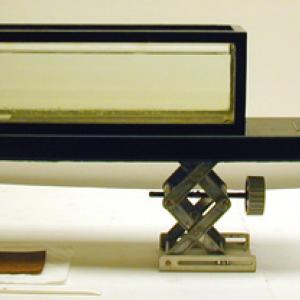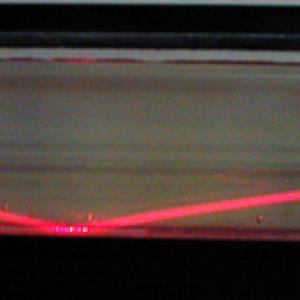College of Liberal Arts & Sciences
6A40.40 - Refraction - Variable Index of Refraction - Mirage
Mix up 5 liters of saturated sugar water. Pour 2 liters of that solution into the bottom of the tank. With the remainder of the stock make 1500 ml solutions that are 75%, 50%, 25%, and 10% saturated. Float the cork pad on the 2 liter saturated solution in the tank and pour the 75% saturated solution over the cork pad then repeat this procedure with the other three solutions. Shine a laser in the flat end of the tank and you should see the laser beam bend toward the bottom of the tank. For an added effect you may place a front surface mirror at the point where the laser beam hits the bottom of the tank. This will give you another curved beam reflected outward.
A variation on this demo is to carefully pour Ethyl Alcohol on top of a layer of water. In this case the beam will curve upward instead of downward.
- John A. Bloom, "Eye-Opening Mirages", TPT, Vol. 60, #2, Feb. 2022, p. 84.
- Gregory A. DiLisi, "The Sinking of the R.M.S. Titanic: A Case Study in Thermal Inversion and Atmospheric Refraction Phenomena", TPT, Vol. 60, #1, Jan. 2022, p. 11.
- Front Cover Photo, TPT, Vol. 60, #1, Jan. 2022. p. 1.
- Yuan Zheng, Zewei Huang, Yanbin Yang, "A Simple Way to Demonstrate and Explain Different Facets of Mirage", TPT, Vol. 59, #6, Sept. 2021, p. 422.
- Mario Branca, "Simulation of the Inferior Mirage", TPT, Vol. 48, # 9, December. 2010, p. 565.
- Mario Branca, "Simulation of the Inferior Mirage", TPT, Vol. 48, # 6, Sept. 2010, p. 372.
- Richard M. Heavers, "Oscillations in a Linearly Stratified Salt Solution", TPT, Vol. 45, # 4, April 2007, p. 241.
- Paul Gluck, "Material and Optical Densities", TPT, Vol. 45, # 3, March 2007, p. 140.
- Lauren Richey, Bailey Stewart, Justin Peatross, "Creating and Analyzing a Mirage", TPT, Vol. 44, # 7, Oct. 2006, p. 460.
- Carl H. Tape, "Aquarium, Computer, and Alaska Range Mirages", TPT, Vol. 38, # 5, May 2000, p. 308.
- Se-yuen Mak, "Showing the Light Path of a Mirage", TPT, Vol. 31, # 8, Nov. 1993, p. 476.
- Jinsong Cui, "A Demonstration of the Apparent Ellipticity of the Rising or Setting Sun", TPT, Vol. 29, # 9, p. 566, Dec. 1991.
- J. Wallingford, "More on Mirage Formation", TPT, Vol. 29, # 8, Nov. 1991, p. 485.
- J.F. Davis and T.B. Greenslade, Jr., "Computer Modeling of Mirage Formation", TPT, Vol. 29, # 1, Jan. 1991, p. 47.
- William P. Crummett, "Hard Rock Optics", TPT, Vol. 24, # 7, p. 414, October 1986.
- John B. Johnston, "Atmospheric Refraction", TPT, Vol. 42, March 2004, p. 184. Reprinted from TPT, Vol. 15, # 5, May 1977, p. 308.
- John B. Johnston, "Atmospheric Refraction", TPT, Vol. 15, # 5, May 1977, p. 308.
- Anna Horvath, Balazs Bamer, Gergely Gabor Barnafoldi, "Numerical Simulation of Mirages Above Water Bodies", AJP, Vol. 91, #12, Dec. 2023, p. 999.
- E. Ray, P. Bunton, J. A. Pojman, "Determination of the Diffusion Coefficient Between Corn Syrup and Distilled Water Using a Digital Camera", AJP, Vol. 75, # 10, p. 903, Oct. 2007.
- C. Gaffney, Cheuk-Kin Chau, "Using Refractive Index Gradients to Measure Diffusivity Between Liquids", AJP, Vol. 69, # 7, p. 821, July 2001.
- Waldemar H. Lehn, "Exact Temperature Profile for the Hillingar Mirage", AJP, Vol. 69, # 5, May 2001, p. 598.
- T. Kosa, P. Palffy-Muhoray, "Mirage Mirror on the Wall", AJP, Vol. 68, # 12, December 2000, p. 1120.
- P. R. Barker et al, "A Superior "Superior" Mirage", AJP, p. 953, Vol. 57, No. 10, October 1989.
- Kevin M. Jones, Scott Lundgren, and Alak Chakravorty, "A Calculus of Variations Demonstration: The Gradient Index Lens", AJP, Vol. 56, #12, Dec. 1988, p. 1099.
- George Spagna, "Laser Beam Deflection by Thermal Gradient", AJP, Vol. 51, #5, May 1983, p. 475.
- K. Tennakone, "A Mirage From a Laser", AJP, Vol. 51, #3, Mar. 1983, p. 270.
- E. Fabri, G. Floria, F. Lazzeri, P. Violino, "Mirage in the Laboratory", AJP, Vol. 50, # 6, June 1982, p. 517.
- M.M. Michaelis, "Laser Beam Guidance by Flames", AJP, Vol. 48, # 11, November 1980, p. 990.
- G. P. Sastry, "Teaching Mirages", AJP, Vol. 46, #7, July 1978, p. 765.
- P. L. Dyson, "Comment on Explaining the Mirage", AJP, Vol. 45, #9, Sept. 1977, p. 879.
- E. Khular, K. Thyagarajan, and A. K. Ghatak, "A Note on Mirage Formation", AJP, Vol. 45, #1, Jan. 1977, p. 90.
- A. J. Barnard, B. Ahlborn, "Measurement of Refractive Index Gradient By Deflection of A Laser Beam", AJP, Vol. 43, # 7, July 1975, p. 573.
- Robert T. Bush, Robert S. Robinson, "A Note on Explaining the Mirage", AJP, Vol. 42, # 9, September 1974, p. 774.
- William M. Strouse, "Bouncing Light Beam", AJP, Vol. 40, # 6, June 1972, p. 913.
- Giuseppe Poggi and Carlo Pontiggia, "The Mirage in The Lab", AJP, Vol. 37, #3, Mar. 1969, p. 332.
- Robert Ehrlich, "10.8: Mirage Formation", Why Toast Lands Jelly-Side Down, p.164.
- T. Kallard, "Curving and Bouncing Laser Beam", Exploring Laser Light, p. 58.
- Pat Murphy, Ellen Macaulay, and the staff of the Exploratorium, "Disappearing Puddles", Exploratopia, p. 289.
- Carl. H. Tape, "Aquarium, Computer, and Alaska Range Mirages", TPT, Vol. 38, # 5, May 2000, p. 308.
- M. Minnaert, "IV, The Curvature of Light Rays in the Atmosphere", Nature of Light and Colour in the Open Air, p. 39.
- Jearl Walker, "Bouncing a Light Beam", The Flying Circus of Physics with Answers, p. 119.
- C. Harvey Palmer, "A Note on the Properties of Inhomogeneous Media", Optics - Experiments and Demonstrations, John Hopkins Press, 1962.
- Tik L. Liem, "The Reflecting Brick Wall", Invitations to Science Inquiry - Supplement to 1st and 2nd Ed. p. 93.
- Julius Sumner Miller, Q14 & A14, Millergrams I – Some Enchanting Questions for Enquiring Minds, p. 21 & 80.
Disclaimer: These demonstrations are provided only for illustrative use by persons affiliated with The University of Iowa and only under the direction of a trained instructor or physicist. The University of Iowa is not responsible for demonstrations performed by those using their own equipment or who choose to use this reference material for their own purpose. The demonstrations included here are within the public domain and can be found in materials contained in libraries, bookstores, and through electronic sources. Performing all or any portion of any of these demonstrations, with or without revisions not depicted here entails inherent risks. These risks include, without limitation, bodily injury (and possibly death), including risks to health that may be temporary or permanent and that may exacerbate a pre-existing medical condition; and property loss or damage. Anyone performing any part of these demonstrations, even with revisions, knowingly and voluntarily assumes all risks associated with them.

